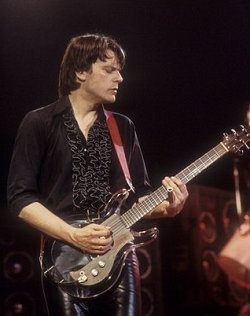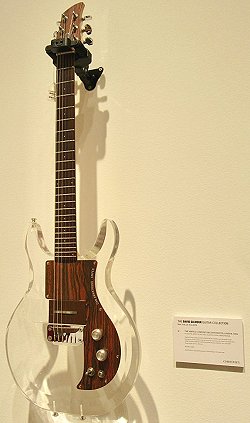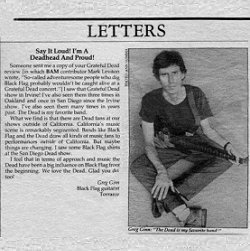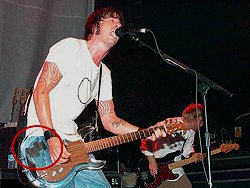

J. Geils (John Warren Geils Jr.) also slung on a Dan Armstrong · Ampeg guitar. Notice the slide on
his 'pinky' finger.
|
|

David Gilmour, guitarist for Pink Floyd played an original Dan Armstrong · Ampeg guitar. While I was unable to find a photo
of him playing it he had this one in his collection until he auctioned it off.
As stated at the auction, applied to the neck tenon is the serial number A1311D. The guitar and case was also accompanied by facsimile copies
of the original sales invoice from California Guitar to Mr. Dave Gilmour, dated 27th September 1979, and the UK customs receipt, dated
the 1st December 1979.
|
|
A day before the auction, Gilmour revealed that the money from the auction would benefit ClientEarth, which funds environmental lawyers and experts
in the fight against climate change. “The global climate crisis is the greatest challenge that humanity will ever face, and we are within a few years
of the effects of global warming being irreversible. We need a civilized world that goes on for all our grandchildren and beyond in which these guitars
can be played and songs can be sung.” It's interesting to note that even decades later Dan Armstrong is, ironically, playing a small part in this.
I can't help but wonder what he might have said. But knowing Dan's personality I'm guessing he would have had some sort of anecdote to it all.
Above left and right, Greg Ginn of Black Flag also utilized a Dan Armstrong plexi guitar.
As seen in most of these photos, his guitar has been modified with a replacement humbucking pickup.
Seen at left, the four 'Black Flag' strips of tape adorn his guitar, while at right, four strips of cloth on a speaker cabinet deliver the same
message.
Above left, I can't quite make it out, but apparently some type of modification has taken place in and around the scratchplate.
At right, and better seen in the enlarged view, a photograph is displayed on top of what looks like a taped up pickguard. Notice
the lack of any knobs or a switch - just an output jack that his patch cord is plugged into.
At left, Ginn playing a Dan Armstrong in an early photo. Notice this guitar has control knobs and a toggle switch. At right, and seen
better in the enlarged view, a clear scratchplate reveals that a Stratocaster style output jack had been mounted on it, while sharp eyes
may have noticed brass saddles like those seen on the reissue rosewood Dan Armstrong models. In the background, it appears that either
the Ampeg speaker cabinet is upside-down, or..... the grille cloth was snapped in upside-down.
At left, Ginn can be seen plays his Dan Armstrong guitar, which appears black in this photo (as he eventually painted it black).
It appears he used grey duct tape in the area of the upper cutaway horn for whatever reason(s). At right Ginn performs with Black Flags second
singer Ron Reyes.
At upper left, notice Ginn's plexi has a metal covered humbucker as well as what looks like a tunable bridge mounted on the original
tailpiece. At right, the bottom speaker cabinet can be seen sporting the black flags on the grille cloth.
At left, Ginn at Santa Cruz, CA in 1985 while at right, on July 22, 1979 Ginn and Black Flag at Manhattan Beach, CA
At left, Ginn with Ron Reyes in Vancouver, Canada 1980. At right, Ginn wrote many, if not most, of Black Flag's material
over the years. Many recorded bass tracks of their material is credited to Dale Nixon - which is Ginn. It's a bogus name
that Ginn created as he picked up the bass in the studio and laid down the bass tracks.
At left, Ginn again plays what appears to be a black Dan Armstrong model. As mentioned earlier however, it is black, but not a prototype model. In the
early ‘80's he spray painted the instrument black. This guitar featured one custom pickup, and eventually was stripped down to feature no volume or tone
pot. Unfortunately, this guitar was stolen in 1984. Greg purchased a second Dan Armstrong, whether it was spurred by the theft of the first, is not known.
On this guitar, instead of the black spray paint, which he had applied to dampen the guitar’s vibrations on the first Armstrong, this second Armstrong became
somewhat notable for all of the duct-tape that he used on it to keep the modifications secure and to achieve the same sonic effect. This one, like its predecessor,
would end up with no volume or tone pots, and the lone pickup was sealed (to prevent rusting from Greg’s heavy sweating). Also, the instrument would
have its instrument cable hardwired to the guitar by going through the hole for the output jack and soldering directly to the pickup's output lead wire.
This Dan Armstrong would be the one that he would use live and in the studio throughout the Slip It In-era, until its own untimely theft in ‘86. According
to Henry Rollins’ that guitar disappeared out of the Black Flag van on April, 16, 1986, in Poughkeepsie, New York, while road manager Mitch Bury watched it
happen from inside the van. According to Rollins "the guitar was stolen through the open window on the passenger’s side." Rollins noted that Ginn
went off immediately to buy a replacement guitar, which turned out to be an all-black 1986 Ibanez Roadstar II.
At right, and given a tall picket type fence, it makes me wonder whether this was a stage or someone's backyard party, not that it matters
as musicians are happy to play most any venue. Notice too that Ginn tapes the upper horn of the Dan Armstrong models in &/or around the strap
peg. He does much the same around the other peg as well. On this model the four black strips of tape representing Black Flag is easily seen and
is also present on his shirt. In both of these photos, notice how what appears to be a tunable bridge mounted, and resting upon the original
Dan Armstrong tailpiece. Notice too, that both have replacement pickups, and many speculate that Ginn equipped them with DiMarzio's
SDHP® though I cannot verify that.
At left, in 1982 and a guitar strap upside-down (perhaps intentional??) - Ginn plays his Dan Armstrong guitar, with tape covering the upper
cutaway horn and a clear plexiglas scratchplate. One can see the tongue of the neck in this shot, as well as a replacement humbucker.
At right, it's often been said that Ginn "gives it his all" when he performs and as such, perspires quite a bit - often to the point that he
has to continually change out pickups and other guitar hardware as they just rust out &/or go bad. This may explain the markings on his left
pant leg - for the dark markings look to be sweat, and in the shape of the Dan Armstrong body - right where it may rest against his leg at times.
Notice too, the Black Flag markings on his shirt.
At left, notice the use of duct tape, not only on the guitars' strap peg but also on a tuner on the headstock and oddly enough, even his guitar
strap. If ya can't fix it.... duct it. At right, and without duct tape, Ginn tears into another number.

|
Ginn along with his Armstrong guitar is photographed for a brief article he wrote for a local newspaper politely rebutting one of Mark
Leviton's articles that was featured in an earlier BAM (Bay Area Music) Magazine.
|
Above left and right, and seen on the television show American Bandstand in 1982 - Rob Grill - lead vocalist and bassist of The
Grass Roots was yet another artist that chose to play a Dan Armstrong · Ampeg instrument. In this video they are
playing their hit song Temptation Eyes which can be found on YouTube. Courtesy of Roy Hedges.
At left and right, when Dave Grohl of the Foo Fighters isn't playing his Gibson Trini Lopez model he grabs for his reissue
Dan Armstrong · Ampeg guitar on stage.
At left, Grohl can be often seen strumming his plexi guitar up higher, or more forward than many others. At right, and playing in Iceland,
some sort of decal or sticker can be seen on the guitar.
At left, Grohl takes to the air with his plexi, while at right, the maple neck of his Dan Armstrong guitar can be seen.
At left, Grohl in concert on Aug 7, 2015 - At right, Dave Grohl poses with BL'AST! guitarist Mike Neider as he volunteered to revive a long lost and forgotten
recording of BL'AST! from back in the 1980's in his recording studio.
At left, Grohl gives a nod to Black Flag with strips of black tape adorning his plexi. Also, and at right, it's been reported that Grohl plays a 2002 re-issue model
Dan Armstrong, but they stopped making the first re-issues in 2001. Also, the re-issue models utilize an extra screw on the scratchplate, situated directly below
the bottom-back screw of the tailpiece (that anchors the tailpiece to the acrylic body). However, back at left, and seen in several other photos, it's obvious that
his guitar lacks this 'extra' screw. Most likely he plays an original 1970-71 model.
At left and right, Dave wears his guitars down low and uses the topmost strap peg on the guitar.
Calling it one of his "favorite guitars ever manufactured", Grohl owns "four Lucite Ampegs - each one tuned differently for
various Foo Fighter songs and are featured in three of the Foo Fighters most popular videos - All My Life, The One and Times Like These.”
Many photos shown above reveal Grohl using single blade/single coil pickups, but as seen here at left & right, his guitar is equipped
with a dual blade humbucking type pickup.
At left and right, Grohl performing in Iceland with the Foo Fighters.
At left and right, Grohl performing in unknown venues. Notice the tape & reference to Black Flag on his
guitar.

|
Grohl and crew in concert. Circled in red. the Black Flag reference is instantly obvious.
|
Above, Grohl with bassist Nate Mendel in concert in 2002. Oddly, the reference to Black Flag on his Dan Armstrong guitar appears to be missing,
suggesting he has more than one Armstrong plexi. At right is Grohl's Dan Armstrong up close. Notice the lack of the
Dan Armstrong · Ampeg white lettering on the scratchplate, suggesting either a replacement plate or the lettering on the
plate has been worn off entirely. Lastly, notice the four pieces of tape, and an ode to Black Flag.
return
menu
Names and images are TMand © Dan Armstrong / Ampeg. All rights reserved.
All other names and images are TMand © of their respective owners. All rights reserved.
|
| |

